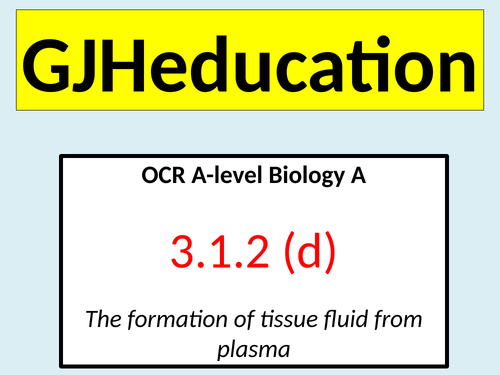



This fully-resourced lesson explains how a combination of hydrostatic pressure and oncotic pressure results in the formation of tissue fluid from plasma. The detailed PowerPoint and accompanying resources have been designed to cover point 3.1.2 (d) of the OCR A-level Biology A specification and includes a section on the differences between blood, tissue fluid and lymph
The lesson begins with an introduction to the arteriole and venule end of a capillary as these will need to be considered as separate entities when describing the formation of tissue fluid. A quick quiz competition introduces a value for the hydrostatic pressure at the arteriole end and students are challenged to first predict some parts of the blood will move out of the capillary as a result of the push from the hydrostatic pressure and this allows oncotic pressure to be initially explored. The main part of the lesson uses a step by step guide to describe how the net movement is outwards at the arteriole end before students will use this guidance to describe what happens at the venule end. In the concluding part of the lesson, students will come to recognise oedema as a condition where tissue fluid accumulates and they again are challenged to explain how this occurs before they finally learn how the fluid is returned to the circulatory system as lymph
This lesson has been written to tie in with the other uploaded lessons from module 3.1.2 (Transport in animals)
Get this resource as part of a bundle and save up to 44%
A bundle is a package of resources grouped together to teach a particular topic, or a series of lessons, in one place.
Module 3: Exchange and transport (OCR A-level Biology A)
This bundle contains 18 detailed and engaging lessons which cover the following specification points in module 3 (Exchange and transport) of the OCR A-level Biology A specification: 3.1.1: Exchange surfaces * The need for specialised exchange surfaces * The features of an efficient exchange surface * The structures and functions of the components of the mammalian gaseous exchange system * The mechanism of ventilation in mammals * The mechanisms of ventilation and gas exchange in bony fish and insects 3.1.2: Transport in animals * The double, closed circulatory system in mammals * The structure and functions of arteries, arterioles, capillaries, venules and veins * The formation of tissue fluid from plasma * The external and internal structure of the heart * The cardiac cycle * How heart action is initiated and coordinated * The use and interpretation of ECG traces * The role of haemoglobin in transporting oxygen and carbon dioxide * The oxygen dissociation curve for foetal and adult haemoglobin 3.1.3: Transport in plants * The structure and function of the vascular systems in the roots, stems and leaves * The transport of water into the plant, through the plant and to the air surrounding the leaves * The mechanism of translocation As well as the detailed A-level Biology content of the PowerPoint slides, the resources contain a wide range of tasks including guided discussion points, exam-style questions and quiz competitions which will engage and motivate the students
Module 3.1.2: Transport in animals (OCR A-level Biology)
Each of the 9 lessons in this bundle are fully-resourced and have been designed to cover the content as detailed in module 3.1.2 (Transport in animals) of the OCR A-Level Biology A specification. The specification points that are covered within these lessons include: * A double, closed circulatory system * The structure and function of arteries, arterioles, capillaries, venules and veins * The formation of tissue fluid from plasma * The internal and external structure of the mammalian heart * The cardiac cycle * How heart action is initiated and coordinated * The use and interpretation of ECGs * The role of haemoglobin in transporting oxygen and carbon dioxide * The dissociation curve for foetal and adult haemoglobin * The Bohr effect The lessons have been written to include a wide range of activities and numerous understanding and prior knowledge checks so students can assess their progress against the current topic as well as be challenged to make links to other topics within this topic and earlier topics If you would like to see the quality of the lessons, download the formation of tissue fluid. heart action and ECGs lessons as these are free
Something went wrong, please try again later.
Thank you for such a detailed resource.
Top quality resource, Thanks
Fantastic resource :)
Report this resourceto let us know if it violates our terms and conditions.
Our customer service team will review your report and will be in touch.